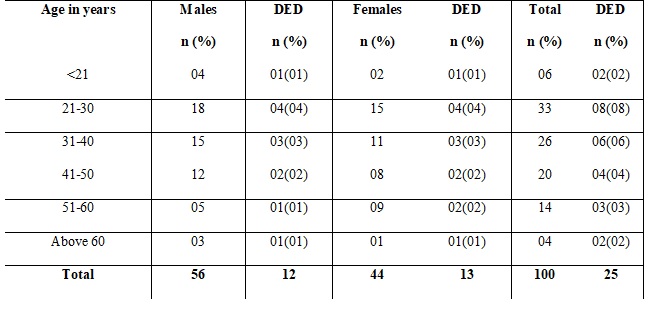A study of assess the prevalence of dry eye and its associated risk factors in a tertiary care hospital
Abstract
Introduction: Dry eye is a major tear deficiency disorder which affects millions of people worldwide. Dry eye refers to disorders of the tear film due to reduced tear production and/or excessive tear evaporation associated with symptoms of ocular discomfort.
Material and Methods: This was a descriptive, cross sectional study carried out at Ophthalmology out-patient department (OPD) of G.C.R.G Institute of medical sciences BKT Lucknow U.P. from December 2016 to March 2018.
Results:In our study, among all the associated risk factors majority of the patients 58 (58%) had dry eyes due to other causes which includes pterygium, conjunctivitis, blepharitis, vitamin A deficiency and senile. 17 (17%) patients were found with allergy& keratitis was found in 12(12%) patients.
Conclusion: Proper counseling of the patients regarding the chronic nature disease with long term treatment and preventive measures are necessary to relieve ocular discomfort and ensure patient satisfaction with a better quality of life.
Downloads
References
2. De Haas EB. The Pathogenesis of Keratoconjunctivitis Sicca. Ophthalmologica. 1964;147:1-18.[pubmed]
3. Gayton JL. Etiology, prevalence, and treatment of dry eye disease. Clin Ophthalmol. 2009;3:405-12. Epub 2009 Jul 14.[pubmed]
4. The epidemiology of dry eye disease: report of the Epidemiology Subcommittee of the International Dry Eye Work Shop (2007). Ocul Surf. 2007 Apr;5(2):93-107.[pubmed]
5. McCarty CA, Bansal AK, Livingston PM, et al. The epidemiology of dry eye in Melbourne, Australia. Ophthalmology. 1998 Jun;105(6):1114-9.DOI:10.1016/S0161-6420(98)96016-X.[pubmed]
6. Lin PY, Tsai SY, Cheng CY, et al. Prevalence of dry eye among an elderly Chinese population in Taiwan: the Shihpai Eye Study. Ophthalmology. 2003 Jun;110(6):1096-101.doi:10.1016/S0161-6420(03)00262-8.[pubmed]
7. Gupta N, Prasad I, Jain R, D'Souza P. Estimating the prevalence of dry eye among Indian patients attending a tertiary ophthalmology clinic. Ann Trop Med Parasitol. 2010 Apr;104(3):247-55. doi: 10.1179/136485910X12647085215859.[pubmed]
8. Basak SK, Pal PP, Basak S, et al. Prevalence of dry eye diseases in hospital-based population in West Bengal, Eastern India. J Indian Med Assoc. 2012 Nov;110(11):789-94.[pubmed]
9. Rege A, Kulkarni V, Puthran N, Khandgave T. A Clinical Study of Subtype-based Prevalence of Dry Eye. J Clin Diagn Res. 2013 Oct;7(10):2207-10. doi: 10.7860/JCDR/2013/6089.3472. Epub 2013 Oct 5.[pubmed]
10. Hikichi T, Yoshida A, Fukui Y, et al. Prevalence of dry eye in Japanese eye centers. Graefes Arch Clin Exp Ophthalmol. 1995 Sep;233(9):555-8.[pubmed]
11. Anuj Kumar Pathak, M. Deepak Lakra, Rajiv Kumar Gupta. Study to assess dry eye among patients of a tertiary care hospital in Jharkhand. International Journal of Contemporary Medical Research 2017;4(9):1861-1864.
12. Basak SK, Pal PP, Basak S, et al. Prevalence of dry eye diseases in hospital-based population in West Bengal, Eastern India. J Indian Med Assoc. 2012 Nov;110(11):789-94.[pubmed]
13. Bhutia KL, Lomi N. A hospital-based study to estimate the proportion of dry eye cases among patients attending the Tertiary Care Hospital, Gangtok, Sikkim. Sudanese J Ophthalmol [serial online] 2016;8:42-5.
14. Shah S, Jani H. Prevalence and associated factors of dry eye: Our experience in patients above 40 years of age at a Tertiary Care Center. Oman J Ophthalmol. 2015 Sep-Dec;8(3):151-6. doi: 10.4103/0974-620X.169910.[pubmed]
15. Shaheerah G, Adil S J, Muhammad F F. Frequency and Risk Factors of Symptomatic Dry Eye Disease at Tertiary Care Eye Hospital, Karachi. Biostat Biometrics Open Acc J. 2018; 4(3): 1-5.

Copyright (c) 2018 Author (s). Published by Siddharth Health Research and Social Welfare Society

This work is licensed under a Creative Commons Attribution 4.0 International License.


 OAI - Open Archives Initiative
OAI - Open Archives Initiative



















 Therapoid
Therapoid

